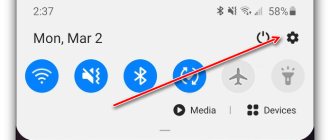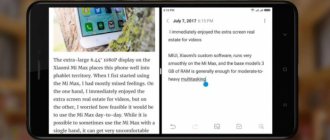- August 23, 2019
- Instructions
- Artem Krylov
Despite the fact that quite often some important elements refuse to work at the most needed moment, the development company has provided some additional tools to help temporarily replace the faulty component. One of them is the virtual Home button.
Further in the material we will provide brief instructions on how to install and how to remove the “Home” button from the screen.
What is the “Home” or “Home” button for on an iPhone?
“Home” is a key that controls your smartphone. Customization involves enabling and disabling its functions, as well as assigning special features. At the moment, “Home” is available on all iPhone models up to 8+.
Touch-sensitive Home buttons appear for the first time on iPhone 7
For your information! The key is often used to return to the home screen, as well as to close third-party applications.
In addition, the user can configure the device under his own control. Home on iPhones, in addition to standard functions, performs the following:
- includes voice control;
- activates the software;
- removes the lock and launches the widget menu;
- closes applications;
- opens a menu section showing all available applications.
The functional features of the key depend on the version of the operating system
With the release of widescreen models (6 and 6+), many users noted that holding the phone in their hand and reaching the necessary icons became more problematic. To make it easier to work with a smartphone, the “Easy Access” function was introduced. A short touch on the Home key reduces the working area of the screen and slides down for a few seconds.
Note! However, not everyone is starting to use this innovation. In addition, for some users, accidentally shrinking the screen only causes inconvenience, so the “Easy Access” function must be turned off.
To do this, you need to go to your iPhone settings and open the “Accessibility” menu. Here you should deactivate the switch in the “Easy Access” section.
You can also adjust the speed at which you press the button in the settings. This is especially convenient for older people, as well as small children who cannot press at a fast pace. Through the accessibility menu, you can select the appropriate speed: fast, slow or very slow.
Users who often hold a smartphone in their hands have more than once noticed that the Siri voice assistant turns on inadvertently. To avoid accidental appearance, it is recommended to disable it through the settings.
What else you can do with Assistive Touch
With Assistive Touch, you can not only customize the Home icon, but also simplify control of your smartphone:
- View notifications through a special icon. Useful if the display at the top is damaged and you can't see what's displayed there.
- Lock screen.
- Increase/decrease volume.
- Change signal mode.
- Open controls if your bottom part of the screen is damaged and you can’t see the options on it.
- Activate the Siri voice assistant.
Sometimes the problem occurs not only with the material Home key, but also with the Power key. Because of this, it is impossible to take a screenshot and lock the display. Proceed as follows:
- Go to Settings - General Settings.
- Open the Accessibility section.
- Turn on AssistiveTouch.
- In the Top-Level Menu, indicate which functions you need - they are all visualized in a compact form.
To avoid having to open Settings every time you want to bring up AssistiveTouch on your display, you can adjust the shortcut:
- Open Settings - General Settings.
- Go to the Accessibillity section again.
- Go to the Hotkey subsection and set AssistiveTouch.
Now a triple tap is all it takes to activate AssistiveTouch.
How to display the Home button on the iPhone screen
All owners of smartphones with updated iOS can add a button to the home screen. Pulling a key onto the display is easy using the special Assistive Touch function.
How to remove screen magnification on iPhone - making icons and icons smaller
How to display the Home button on the iPhone:
- Open basic settings.
- Go to the accessibility section.
- Here you can find the Assistive Touch item.
After clicking on the activating line, the function will work. This is one of the simplest and fastest ways to remove an on-screen button.
For your information! After completing these steps, an icon will appear on the phone display that has a standard set of actions.
How to Customize the Home Button on iPhone
How to remove screen blur in Windows 10 - description of methods
The user can set convenient settings at any time. To prevent accidental clicks, it is recommended to use the easy access switch. The function is designed for people who are uncomfortable using smartphones with large displays.
Reachability mode allows you to control the gadget with one hand
This addition is recommended to be used only in extreme cases, and in normal cases it is advisable to remove it. Disabling the function will reduce the risk of accidental clicks and ensure correct operation of the phone.
How to reduce the pressing speed was described above. All manipulations with the “Home” button are carried out through the universal access settings. Here the menu contains various functions that you can explore and choose the most convenient for you.
Note! Multitasking a button allows you to assign it a triple click, which will perform a specific action. You can find out the list of available options through the main settings. Here you need to find the “Keyboard shortcut” item, which is in deactivated mode by default.
Suggested combinations:
- shades of gray;
- color inversion;
- voice guidance of the interface;
- screen enlargement;
- virtual controller;
- Assistive Touch.
Virtual Home Button on iPhone
The virtual button has the following features:
- simplifies smartphone management for people with disabilities;
- allows you to use the screen instead of constantly clicking on the raised button;
- saves a smartphone when a standard key fails;
- provides quick access to the Siri application;
- protects the gadget from wear and damage;
- available for configuration on all phones starting from version 3GS.
To install a virtual button, you must familiarize yourself with the Assistive Touch add-on
This option is responsible for connecting and removing a screen key. The setup is carried out through the standard iPhone menu. In Accessibility, select “Assistive Touch” by activating the switch slider. There is a parameter called “Opacity” that you can customize to your liking. In rest mode, it is best to set the transparency to a minimum so that the outline of the key is not noticeable during normal use of the gadget.
Next, you need to configure the appropriate actions by selecting them from the list. The most useful functions are configured to touch a button, double click, hold and 3D press. You can assign 4 quick actions to one key at once. The following options are relevant: locking screen rotation, muting sound, adjusting volume and calling Siri.
Note! The virtual button can be placed in any convenient location on the screen.
Additional settings for the virtual button
AssistiveTouch does more than just the tasks of a physical Home button. The user can set any other function for it depending on his own preferences. In this case, AT use cases expand significantly. After all, this component becomes useful even if the “Home” button on the smartphone is absolutely working.
Among the alternative possibilities it is worth highlighting the following:
- Siri;
- Command centre;
- Screen lock;
- Raising or lowering the volume;
- Quick command;
- Switching programs.
They are used instead of the Home button. In addition, AssistiveTouch can be set to a top-level menu. This is a special dialog box that opens after clicking and allows you to access several functions at once.
Usually people turn to pre-registered functions for help. But at the same time, you are allowed to create your own gestures. That is, anyone can show their creativity by adding new AT capabilities.
All parameters are adjusted through the settings section to activate the virtual button. Thus, the iPhone owner does not need to use additional software to gain access to the advanced functionality of the control. More detailed information about this component of the system is presented in the video.
Using the Home Button on iPhone with Assistive Touch
Using the virtual button allows the user to adjust the volume of audio and calls, lock the screen, reboot, control the screen using gestures, and configure other functions.
After activating the button, the corresponding icon will appear on the screen. You can drag it with your fingers to any place that is convenient for the user to touch. By default, after a single click on the button, the Assistive Touch menu is called up. To close it, you need to press 1 time anywhere outside the main menu.
There are several ways to enable Assistive Touch. The first is to launch through the settings menu, where the “Universal Access” item is selected. In the “Touch” section, check the box next to Assistive Touch.
Important! You can use the voice assistant Siri. Just say “Siri, turn on Assistive Touch” and the application will launch.
You can also configure the on-screen button through the “Short commands” item, which is located in the universal access section. If desired, the Assistive Touch function is added to the list of shortcut commands. In this case, it is convenient to open the on-screen button through the control center or through the Home button.
Assistive Touch can be used instead of various gestures
This simplifies the management of the notification center, switching programs, and also provides easy access to settings. The button can be responsible for playing the screen out loud, searching, and returning to the main screen.
Assistive Touch is often used instead of the usual button clicks. For example:
- fast universal access;
- screen lock;
- calling a voice assistant;
- rebooting the smartphone;
- take an image from the screen (screenshot);
- simulating shaking of the device.
For your information! The key can be configured for multi-finger gesture control. To do this, go to the on-screen button menu, select “Device” - “More” and click “Gestures”. Here you need to select the number of fingers that will participate in gestures (from 2 to 5). After confirmation, dots will appear in the background of the display, which are responsible for where your fingers touch the screen.
The Home button is considered the most multifunctional on Apple smartphones. It can be used in standard form or displayed on the screen, which is especially important if the key has become unusable. Depending on the model, the button is presented in mechanical and touch types. Through the settings, its purpose and function are changed.
Auxiliary options
When you entered the settings menu for the virtual Home button, you may have noticed that there is an additional list of parameters and settings.
Among them:
- single press of a virtual key;
- double tap;
- long press of the button;
- element transparency level;
- customization of the top menu level.
All of them help to adapt such tools for comfortable work with the device, and if they are not assigned at least by default, then it will not be possible to display a substitute for a physical button on the screen (although functions are constantly assigned to them).
Now you can move on to the main instructions of the article.










